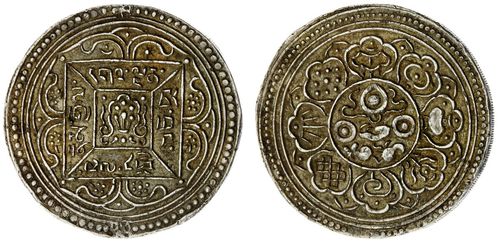Auction: CSS96B - CHINESE BANKNOTES AND COINS FEATURING THE MR. LAI PO HUNG COLLECTION OF CHINESE BANKNOTES &
Lot: 1664
China, Qing Dynasty, Tibet, [PCGS AU Details] 10-Tam pattern, 27.63g, undated (c. 1910), norbu within central square panel within a second square divided by diagonal lines, legend (starting in the upper trapezium and continuing clockwise) dga' ldan pho brang phyogs las rnam rgyal (the Gaden Palace, victorious in all directions), denomination near the rim at 12 o'clock and 6 o clock: tam bcu ("ten Tam") only the letter "t" of the word "tam" is visible, rev. five symbols within a circular panel, surrounded by the eight auspicious symbols within a lotus-petal design (YZM 381; KM Pn 3), PCGS AU Details (Edge Repaired), cert. #45306491, Wolfgang Bertsch Collection, with attractive rich dark tone, repair is minor at edge, extremely rare. The weight standard of this pattern coin seems to be modelled on the Chinese silver Yuan which again followed the weight standard of the South American and Mexican 8 Reales silver coins which circulated in China, and some of them also were found in Tibet. The obverse of the coin shows the same design and inscription as the well-known Monk Tangka (KM Y#14). The double arches attached to the trapeziums are copied from the Nepalese Mohars struck in the name of Pratap Simha which were specially struck for export to Tibet. The denomination tam bcu ("ten Tam") has only the letter "t" of the word "tam" visible, as the final letter "m" is probably indicated by a small circle (in Sanskrit known as anusvara) placed above the letter "t", off flan. The reverse design is only found on this coin. It represents the five symbolic objects which stimulate the senses (Tibetan: ´don yon sna lnga): The mirror (me long) symbolizes the physical forms (gzugs) that appeal to the eye. The two peaches (shing tog) on either side of the mirror are pleasing to the taste (ro). The pair of cymbals (sil snyan) below the mirror represent the sounds (sgra) which reach the ear. The pieces of cloth that are attached to the cymbals excite the sense of touch (reg bya). The conch shell (dung) below the cymbals is supposed to contain a fragrant liquid which stimulates the faculty of smell. A coin of this type was sold in the Rhodes Collection for HK$320,000 (Spink, Hong Kong, August 21, 2013, lot 297). The coin from the Bertsch collection is illustrated by Wang Chun Li: "Illustrated Catalogue of Chinese Gold & Silver Coins; 1791-1949" (Zhong guo jin yin bi mu lu), Zhong guo shang ye chu ban she (China Trade Publishing House), Beijing 2012, p. 89, no. WS0275.. The illustration in the catalogue of YZM (no. 381) has been copied (without indicating the source) from Gabrisch, Karl: Geld aus Tibet. Sammlung Dr. Karl Gabrisch, Winterthur and Rikon, 1990, plate 21, no. 90. There exists a smaller coin (29.2 mm) of the same design the obverse of which is inscribed near the rim with the syllables tam lnga (five tam) and is illustrated by YZM as no. 387.
西藏10兩銀樣幣,PCGS AU Detail,幣邊有修補,罕見
Sold for
HK$200,000
Starting price
HK$200000







